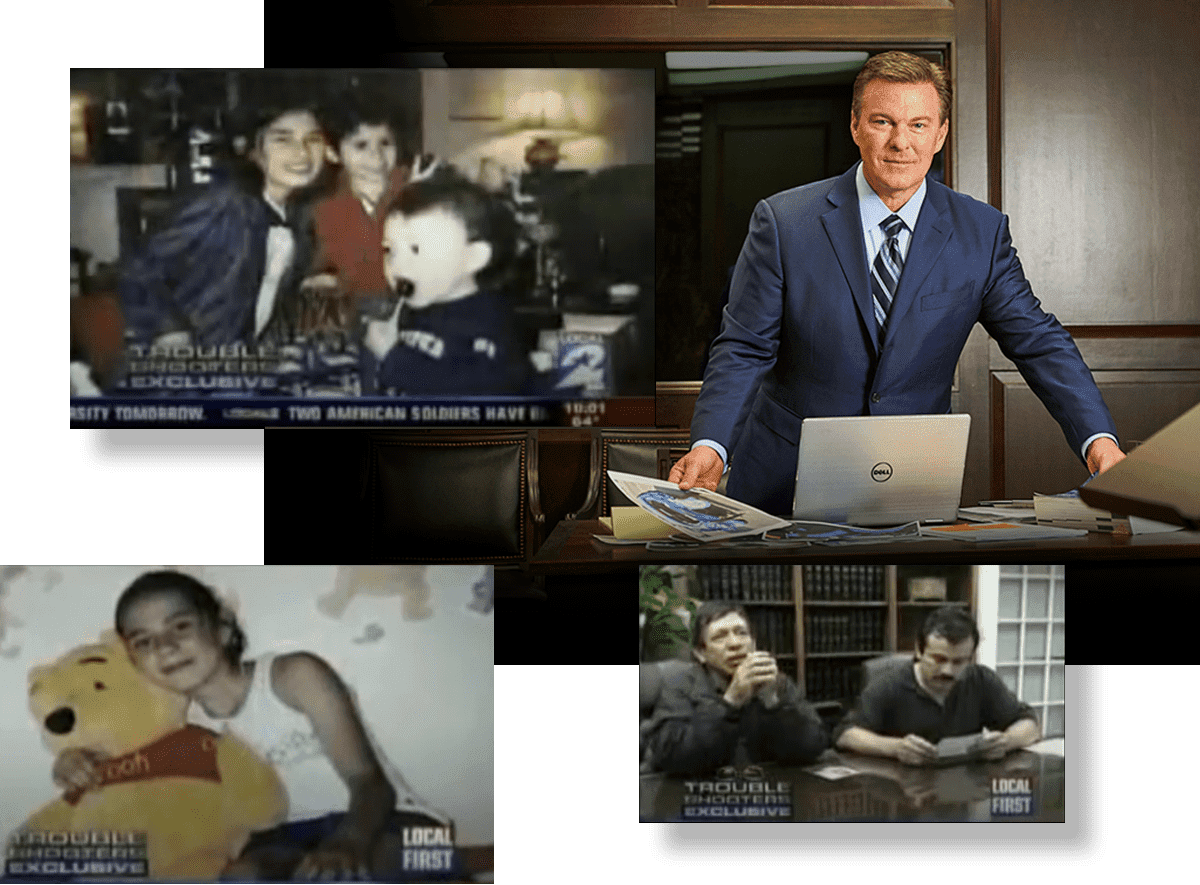
Below are some of the injuries our firm has handled over the years:
1. Brain Injuries
Brain injuries can have lasting and severe consequences for victims, potentially changing their lives forever. According to the Mayo Clinic, traumatic brain injury (TBI) is a typical injury in falls and car accidents and can range from mild to severe and life-limiting.
Brain injuries can take some time to heal; some may be permanent, requiring round-the-clock care. When you experience a brain injury, you want to ensure you receive the medical care, rehabilitation, and support you need to move forward.
2. Back Injuries
Back injuries, such as herniated discs and muscle sprains, are extremely common and can drastically impact your quality of life. They can occur with home and work activities, such as picking up a box the wrong way or moving a heavy piece of furniture. Serious accidents involving trucks or defective products can also cause debilitating back injuries.
Individuals with back injuries often find the injury progressing over time and may develop chronic pain. If you suffer a back injury, whether at home or work, promptly seek medical treatment to avoid worsening the injury.
3. Neck Injuries and Whiplash
Whiplash and other neck injuries may seem like nothing more than an inconvenience. However, neck injuries can be debilitating and impact your daily life more than expected. Whiplash, if severe, can cause chronic pain and stiffness and may result in a reduced range of motion. Moreover, recovering from a neck injury, such as whiplash, typically requires physical therapy, pain management, and adjustments to your daily routine.
It is noteworthy that the symptoms of whiplash may not show immediately after an accident. Therefore, seeking medical help after a car crash can be crucial for your well-being, even if you feel fine. Early detection and treatment of neck injuries could help you get back on your feet quicker.
4. Spinal Injuries
Damage to the spinal cord can occur in various circumstances, including falls from a height and vehicle accidents. Spinal injuries are often irreversible and can have devastating consequences on your life and health, affecting your mobility, sensation, and overall life quality. They may also require costly ongoing medical attention and rehabilitation therapies.
In addition, the emotional impact of a severe spinal cord injury, such as paralysis, can be significant. Seeking medical and, if another caused your injury, legal assistance can be crucial if you experience a severe spinal cord injury.
5. Burn Injuries
Even minor incidents like hot liquid spills can result in painful and severe burns. Burn injuries, whether from fire, chemicals, or other causes, can considerably disrupt your work and home life. They may also require extensive medical treatment, such as skin grafts. Moreover, the permanent scarring and disfigurement that victims with serious burns typically experience can have a severe psychological impact, potentially leading to self-esteem issues and depression.
Burn injuries can happen in many contexts, including workplace accidents and vehicle collisions. If you or a loved one has suffered a burn injury, seeking prompt medical attention can prevent infection and ensure a good outcome.
6. Fractured and Broken Bones
Depending on their severity, fractures might require casts or even surgical intervention to realign the bone. Beyond the physical discomfort, broken bones can also severely limit your life and keep you away from work and recreational activities for weeks or months.
In addition, complex fractures could cause long-term problems like nerve damage, joint issues, and limited mobility. If you experience a broken bone in a car accident, slip and fall, or another incident, seek immediate medical care to ensure proper healing.
7. Lacerations and Cut Injuries
Cuts and lacerations can occur in various circumstances, including falls, dog attacks, and vehicle accidents. While cuts may seem harmless initially, they can have broader consequences for your health. Sometimes, nerve damage occurs with deep cuts and laceration injuries, which could lead to loss of function and sensation in the affected body part.
Lacerations can be prone to infection and might require stitches or even surgery to speed up the healing process. Consider getting such injuries treated by a doctor as soon as possible, especially when they are deep or caused by dog bites. Professional medical treatment can help lower the infection risk.
8. Shoulder Injuries
Shoulder injuries can arise at home, while playing sports, in a car crash, or at work. Simply reaching for something overhead and overextending the shoulder ligaments and tendons can lead to painful strains, sprains, and dislocations. Surgery may be required in more severe shoulder injuries, such as fractures and dislocations. Common shoulder injuries can include:
- Dislocations
- Frozen shoulder
- Sprains and strains
- Torn rotator cuffs
- Fractures
While some shoulder injuries improve with rest and elevation, it is always a good idea to visit a doctor to rule out a more serious injury and receive speedy treatment.
9. Soft Tissue Injuries
While soft tissue injuries are often considered less severe than other types of injuries, they can be debilitating and may require a considerable recovery period. Soft tissue injuries include sprains and strains affecting muscles, tendons, and ligaments.
Such injuries can result from overexertion, car accidents, slips and falls, and other causes. Unlike fractures and other visible injuries, soft tissue problems may not be immediately apparent, making them easy to dismiss initially. However, seeking timely medical attention can be crucial to prevent exacerbation.
10. Catastrophic Injuries
The term “catastrophic injury” describes a range of conditions that can cause severe physical damage to the body. Such injuries are typically permanent and may be life-changing. Examples of catastrophic injuries include:
- Paralysis
- Amputation of a limb or limbs
- Severe burns
- Loss of a sense, such as hearing or sight
- Organ damage
- Severe nerve damage
- Brain injuries
This list is not exhaustive; many other types of catastrophic injuries exist. Potentially, any injury that severely impacts your life quality and ability to work may be classified as catastrophic.
11. Internal Injuries
Internal injuries can result from blunt force trauma and car accidents, among other causes. They may affect organs, blood vessels, and tissues. Internal bleeding and injuries are typically invisible, making them challenging to diagnose and treat.
Individuals with internal organ damage and bleeding typically require emergency medical treatment to survive these grave injuries. Depending on the severity of internal injuries, affected individuals may also face long-term health complications even when they receive swift medical care.
12. Foot and Ankle Injuries
Foot and ankle injuries can be relatively common at home, work, and while running errands. Foot and ankle injuries can involve:
- Fractures
- Sprains and strains
- Ligament damage
- Twists (ankle)
While foot and ankle injuries can seem harmless initially, they can severely limit your mobility and affect your ability to walk, stand, and engage in normal daily activities. Seeking prompt medical help when injuring your foot or ankle can be critical for avoiding future complications.
13. Knee Injuries
Functioning knees are essential for your mobility and managing daily life. Hurting your knee, whether in a car crash or a fall, can keep you away from work for extended periods and affect your home life. Common knee injuries can include:
- Ligament tears (such as the ACL or MCL)
- Dislocations
- Meniscus injuries
- Fractures
Recovering from knee injuries can take longer than you think and may involve rest, physical therapy, and, if necessary, knee surgery.
14. Disfigurement and Facial Injuries
Facial injuries and disfigurement can occur due to burns, scarring, cuts, fractures, and other injuries. Such injuries, especially if permanent, can place a severe emotional burden on individuals, potentially impacting their social interactions and self-confidence.
Individuals suffering disfigurement and facial injuries may also experience significant ongoing pain and discomfort. Moreover, severe facial injuries may require extensive, costly, and painful cosmetic procedures, such as corrective surgeries and skin grafts.
15. Nerve Injuries
Nerve injuries can impact your life considerably. Nerves are responsible for providing communication between the brain and the rest of the body, enabling us to move and experience sensations. When nerves or their protective coatings are injured, this crucial communication process can be disrupted, potentially causing various problems. Common nerve injury symptoms include:
- Pain
- Numbness
- Tingling
- Loss of sensation
Recovery from nerve injuries can be complex, often involving rehabilitation and sometimes surgical interventions. If you suspect a nerve injury, seeking prompt medical attention can be essential to prevent further damage and promote recovery.
16. Crush Injuries
Crush injuries can be frightening and excruciatingly painful. They can occur in various scenarios, including on construction sites involving heavy equipment and in motor vehicle accidents. Severe crush injuries can cause devastating damage to your bones, muscles, and internal organs.
Severe crush injuries can be life-changing, leading to loss of function and permanently reduced mobility. In the worst cases, they can lead to limb amputations. Early medical intervention and emergency treatment can be critical if you experience a crush injury.
17. Birth Injuries
Birth injuries can cause much suffering for a family and newborn. They can also lead to financial hardship, especially if the child suffers developmental delays and lifelong physical impairments, requiring round-the-clock care.
Birth injuries typically occur during labor and delivery and can result from various factors, including prolonged birth and medical errors. Birth injuries can include:
- Facial nerve damage
- Fractures of the collarbone
- Dislocations
- Brain damage
Management of birth injuries typically involves specialized medical care, surgeries, rehabilitation therapies, and ongoing support for the child and family.
18. Limb Loss and Amputation Injuries
Limb loss and amputation refer to a limb’s partial or complete loss due to accident injuries or medical conditions. Amputations can lead to profound physical challenges and a complete change of lifestyle. In addition to the physical adjustments, such injuries can be emotionally challenging and trigger feelings of loss, anxiety, and depression.
After a limb loss, your recovery and adaptation typically involve a combination of medical procedures and rehabilitation therapies. If you have experienced the loss of a limb, healing and getting your life back on track can take a considerable amount of time.
However, with physical therapy and high-quality prosthetic devices, you could restore function, regain independence, and even return to work.
Get Legal Help for Injuries You Have Suffered
If another caused your injury to their negligence or recklessness, you deserve to be made whole again. While we cannot turn back time and restore your health, we could fight for maximum potential compensation. A fair settlement can help you get the medical treatments, medical devices, and income replacement you need to heal and get your life back on track.
The Ammons Law Firm can be your advocate, leaving no stone unturned in helping you get the justice and recovery you deserve. Don’t wait too long to seek legal help, as the time to file a personal injury lawsuit is limited. Contact us for now for a free, no-obligation case review.
You can read our personal injury law resource to learn more about the cases we handle.
Our Houston personal injury lawyers are prepared to fight for you. Call us at (281) 801-5617 or contact us online for help recovering compensation in your personal injury case.
























